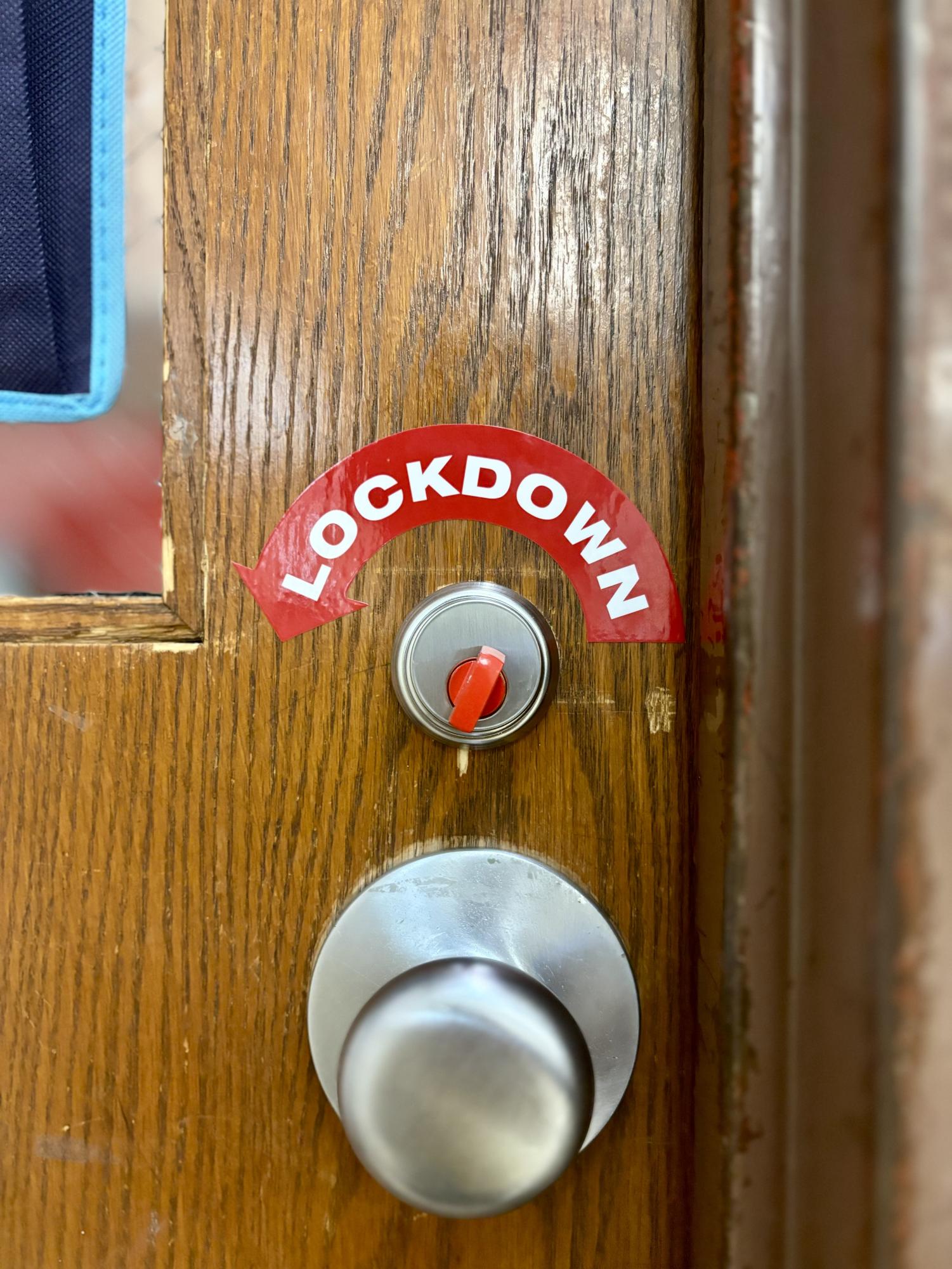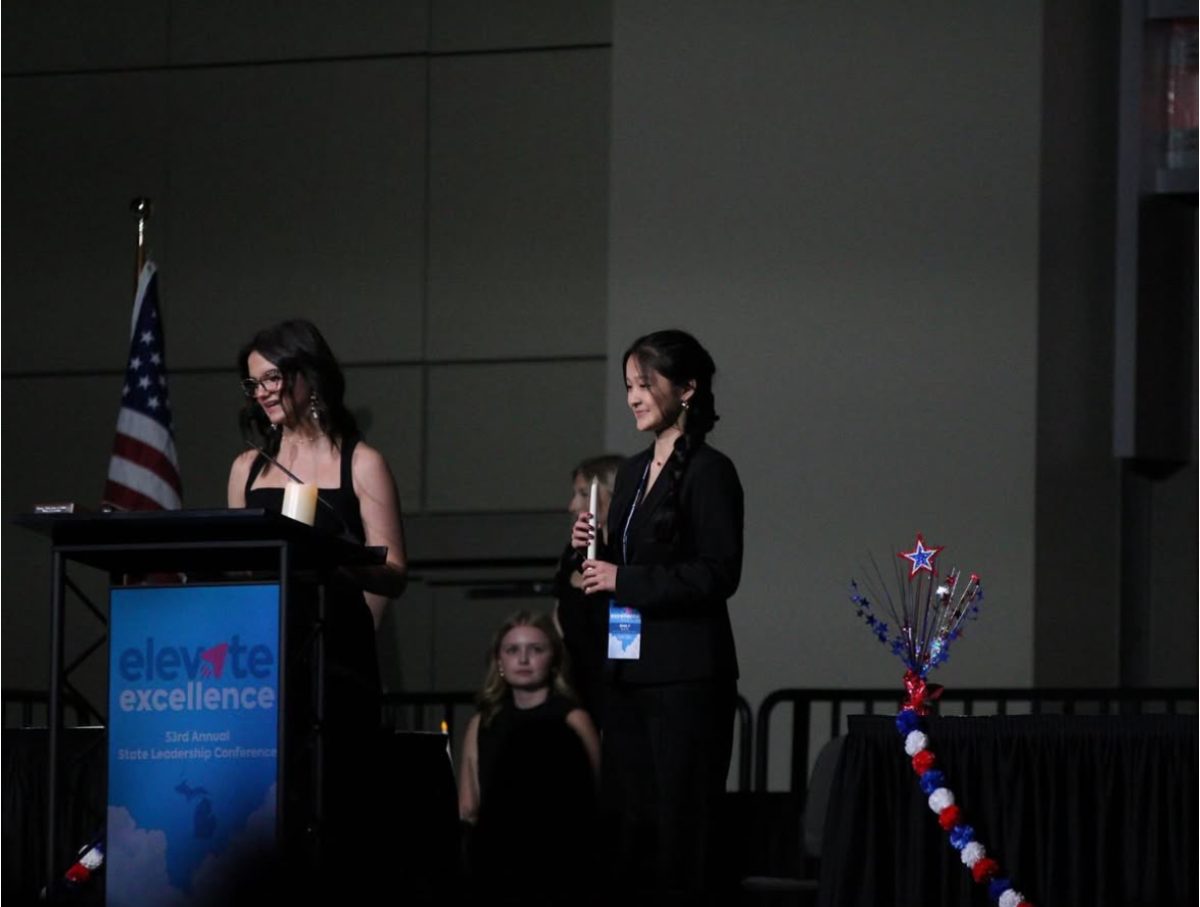Thumb locks to threat assessments: Ann Arbor’s evolving school safety strategy

Walking the halls of any Ann Arbor Public Schools building, you’ll see bright pops of color on every door: the newly installed red thumb locks, a small yet powerful symbol of the changing landscape of school security. In the wake of the precipitous rise of gun violence, especially in schools, school districts are adjusting their safety measures to protect students. For Ann Arbor, that starts with these locks.
In a district with 33 buildings and thousands of classroom doors, there are a variety of different locking systems and door models.
“Our doors are not consistent,” said Liz Margolis, the Executive Director of School Safety for the district. “It gives us consistency with the same ability for every teacher in every classroom to be able to quickly lock their doors.”
The thumb locks are now being installed on every door in every building as part of stricter safety codes.
“What the thumb locks do is they provide a quick way for staff for doors that may have to be unlocked or locked with a key in an emergency situation,” she said. “You’re always looking to do the least amount of gross motor skills during an emergency situation so you don’t have to think about it a lot.”
New building safety codes also will impact perimeter doors.
“You guys have 60 outside perimeter doors, and I could probably walk around this building right now and find one of them propped open,” Margolis said, referring to the entrances to Huron High School. “But we’re going to be putting contact alarms on all the perimeter doors so that anytime a door is propped or not closed properly, those contact alarms will ring and then we can go out and check those doors.”
Teachers and staff in the district are trained on ALICE protocol, which involves multiple levels of threat response. The most severe is the classic lockdown, in which a threat has been determined inside a school building.
“Any staff member in the school that sees something emergent can use our Raptor system to initiate a lockdown,” Margolis said. “It’s a two-way communication with the administration team. I receive all of these so I know in real time what’s going on within each school and what the situation is.”
Raptor is the online third-party system used by the district for all drills and emergency situations.
“In the Raptor system, there’s accountability,” Margolis said. “Every classroom teacher has the class list in there, and they need to account for all their students.”
Once a lockdown begins, teachers continue to communicate with administrators like Margolis through Raptor, who then make the connection to law enforcement.
“A student’s responsibility is to follow their teacher’s lead,” she said.
Another level of response is a lock-out, which happens when a violent crime has occurred in the area that could potentially put students at risk.
“A good example of that is a bank robbery,” Margolis said. “The police will inform us that there has been a bank robbery, the suspects are on foot, and are headed in a direction which could be in the direction of the school. Not much changes because we already keep our perimeter doors locked in our schools, but what does change is that no one can come in or out until we get an all-clear.”
Other threat responses include a hold, in which emergency medical services are called into a school and the halls need to be kept clear, and an evacuation, in which students must exit the building due to a fire or gas leak.
While most of the district’s safety protocols have remained consistent over the years, events like the school shooting at Oxford High School in November 2021 trigger thorough reassessments. The district works with another third-party security company, Secure Environment Consultants, that does a full check of properties and procedures every 18 months.
“We’re always reviewing what’s happened after a school shooting and seeing how we can upgrade our protocols and our physical schools,” Margolis said. “We’re always looking at ways to not only physically but in their protocols improve what’s going on. I did a thorough assessment of the Oxford report and compared it to our protocols and our response protocols.”
One of the main concerns with the Oxford school shooting, however, was not the physical security of the building. Instead, the Oxford school district is under fire for not recognizing early warning signs and potentially stopping the perpetrator from carrying out the shooting.
“You were responsible for keeping us safe,” one student said to the Oxford school board at a meeting last November. “We trusted you. You will never earn that trust back.”
According to Michael Sumerton, Huron’s assistant principal, Oxford school administrators came to Huron and met with Huron’s staff.
“We’re much more vigilant,” he said.
Margolis claims that AAPS has a very low tolerance for threats.
“We have a very thorough threat assessment process for threats of harm and self-harm that our administrators, our counselors, our social workers, or psychologists are all trained in,” she said.
The district monitors student emails and student searches through Securly, another third-party service.
“It’s no secret that your emails from your district email and your searches in your Chromebooks are tracked for certain keywords,” she said. “And they’re tracked not just by keywords, but the system we use actually has human tracking as well.”
There are three levels of moderation within the flagged searches that cause administration to respond in different ways.
“I probably get, in a week’s time, 30 to 50 security notices that are wide-range,” Margolis said. “They’re not all threats.”
Social media is also monitored, and anonymous tips are accepted. If a student has a picture posted with a weapon, that student is put out on emergency leave, and is not allowed on campus until a full threat assessment is completed.
“It’s really to help the student, it’s not to penalize them,” Margolis said. “The whole idea of a threat assessment is to stop things before they happen and get students the support that they need.”
This support comes as a combination of mental health services and the involvement of law enforcement. According to Margolis, the district has a very close relationship with the local police department.
“The threat has to be very specific in order for us to take action to close a school,” she said.
In the past two years, schools have been closed for a threat twice. One was Pioneer High School, which closed because it was “concerning enough” to administrators to involve police. As a result of the investigation, Margolis says that one student was charged with an offense for the threat.
“We will always report these, and we work very closely with the prosecutor’s office,” she said. “We don’t want to do that. But also we can’t have that kind of stuff happening. We can’t have threats being made showing a weapon.”
A full threat assessment involves police checking a student’s home for a weapon and contacting their parents or guardians.
“We have very strict protocols about those situations,” Margolis said. “We will never put staff and students in a dangerous situation. And if we can’t reach an assessment, then we will close school for a day while we work through that. The vast majority of them we take care of right away.”
At the same time, the district also helps connect students with mental health services. Margolis claims that there is a close relationship with the University of Michigan’s emergency mental health services and Community Mental Health’s emergency response team.
“We have made all these connections in the community to help families,” she said. “We’ve done this for staff as well with mental health needs so that we can help them and get them the services they need.”
However, Margolis says public mental health services come with long lines and a major backlog, and the district can’t provide private services.
“There’s not a magic answer, but we’re looking at other ways because the need is so great,” she said.
One resource that AAPS doesn’t provide, however, is school resource officers (SROs). SROs are members of the police department permanently stationed inside the school.
“It didn’t happen during your time, but for 50 years, we had school resource officers,” Margolis said. “They were in school every day. I will say that they performed a valuable service. When I went to school here, we had a great school resource officer that everybody loved.”
SROs were removed from AAPS schools over a decade ago due to budget cuts.
“I think they’re valuable and I think this district needs them,” Margolis said. “It’s very political. There will be people that will say ‘I don’t want officers ever in our schools.’”
SROs do not wear uniforms when in schools, but they are typically armed.
“We will have a small but vocal group of families that never want to see that happen,” she said. “I think it puts us as a district at a disadvantage.”
As the district continues to re-evaluate its safety measures and threat assessment procedures, both new and old buildings will start to see changes in security. However, Margolis says that security measures will still be balanced with a positive educational space.
“Some schools in Texas and Florida, for the most part, are prison campuses,” she said. “They’re fenced all the way around campus. And that is not what we will ever be. Our safety measures have to complement the environment here, the learning environment, so we will never be in that position. That’s not what we’re about.”
For the students who live in fear of tragedy striking Huron, Sumerton is confident that they have nothing to worry about.
“Restaurants, movie theaters, your neighborhood, all of those are more dangerous than here,” he said. “This is the safest place you’ll ever go.”
Your contribution will support the student journalists of Huron High School, help us to offer scholarships, cover our annual website hosting costs, and most importantly, allow us to keep recording history.








